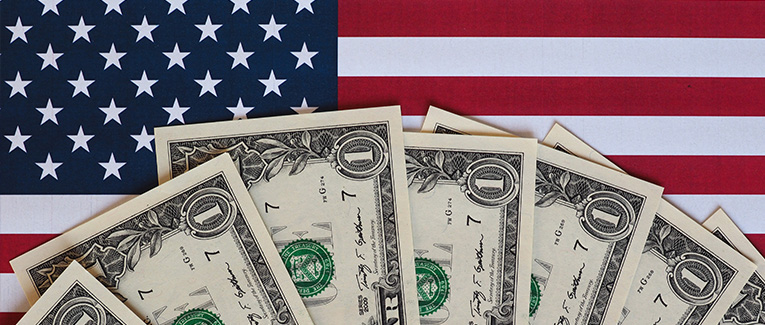
When coming to the USA, you should know the basic information about U.S. currency and the various bills in circulation. U.S. currency is produced at U.S. Treasury locations in Washington, D.C., and in Fort Worth, Texas.
All bills are the same size, irrespective of denomination.
Dimensions: Width 2.61 inches x length 6.14 inches.
Thickness: 0.0043 inches.
Paper: 25 percent linen, 75 percent cotton.
Red and blue synthetic fibers of various lengths are distributed evenly throughout the paper.
Although all denominations are the same size and the same green color, the amounts are clearly printed on the bills (currency notes are called bills in the U.S.). The designs are also similar. Pay careful attention when counting out paper money. It is easy to confuse the denominations and to make a mistake, giving a $10 bill, for example, when you intended to give a $1 bill.
$1

George Washington

Great Seal of the United States
$2

Thomas Jefferson

The Declaration of Independence
$5

Abraham Lincoln

The Lincoln Memorial, Washington, D.C.
$10

Alexander Hamilton

U.S. Treasury
$20

Andrew Jackson

The White House, Washington, D.C.
$50

Ulysses S. Grant

U.S. Capitol, Washington, D.C.
$100

Benjamin Franklin

Independence Hall, Philadelphia, PA
Federal Reserve Branches
There are 12 Federal Reserves in the United States. The serial number of the bill shows one of the following prefixes according to the Federal Reserve it is attached to.
| Prefix | Federal Reserve |
| A1 | Boston |
| B2 | New York City |
| C3 | Philadelphia |
| D4 | Cleveland |
| E5 | Richmond |
| F6 | Atlanta |
| G7 | Chicago |
| H8 | St. Louis |
| I9 | Minneapolis |
| J10 | Kansas City |
| K11 | Dallas |
| L12 | San Francisco |

